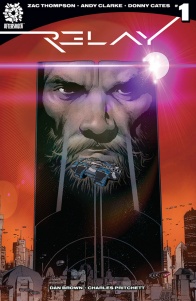A mysterious monolith urges a world to be found while the whole galaxy undergoes cultural homogenization. Our review will contain minor spoilers.

Written by Zac Thompson
Illustrated by Andy Clarke
Colored by Jose Villarubia & Dan Brown
Lettered by Charles PritchettA perfect future of intergalactic travel and community. Every newly discovered planet is unified culturally through a monolithic structure known as the Galactic Relay. Although the towering monument is meant to inspire conformity of ideas, technology, and progress – many resent the foreign structure. Jad Carter, a Relay employee, must keep the peace and act as an emissary to new civilizations. But when he finds the Relay’s mythological creator, Hank Donaldson, his idea of reality and the universe shatters.
Equal parts The Fifth Element and Philip K Dick, Relay is an exploration of monoculture, identity, and the deceptive nature of legend set in a thriving future where humanity forcibly assimilates new worlds.
Written by Zac Thompson (The Dregs) and art by Andy Clarke (REPLICA, Batman). Story by Zac Thomson and Donny Cates (BABYTEETH, God Country, Redneck)!
“I should yield to reality. I have never yielded to reality. That’s what science fiction is all about.” – Philip K. Dick
A vertiginous double-page splash introduces the Relay, a foreboding alien structure in the center of LA. “Find Donaldson’s world,” the relay says. This repetitive refrain refers to the messianic figure behind bringing the Relay to Earth and the legendary first planet. Besides those three words, it’s unclear how the Relay communicates its monocultural imperative. Questions abound in the first issue of “Relay” but its enigmatic nature ought to entice readers onward.
Jad, William, and Victoria are enforcers of the Galactic Relay’s will, though they have conflicting ideas about Donaldson and his Relay. Their back-and-forth exchanges represent the dual beliefs that the Relay has inflicted upon humanity. Jad is for the Relay. He’s a man of faith who finds its message inspiring and wholeheartedly believes in Donaldson’s existence. “Untouched worlds need to be synced until there are no plural realities. Until there is one truth.” It’s a fascinating piece of dialogue clearly expressing the dystopian mission of the Relay and people like Jad who enforce it. On the other hand, William and Victoria are far more cynical, viewing Donaldson as a mere fiction used to brainwash society. It’s unclear why they even work as enforcers, but one can imagine it wouldn’t be so hard for many to sacrifice their principles for a paycheck.
The trio of Relay employees stops protestors and terrorists who function as their mirrors, reflecting their beliefs taken to the extreme. As Victoria notes to Jad, his uniform is the only thing keeping him from the same fate as the pro-Relay terrorist. But the same is true for her and William regarding anti-relay sentiment. This is a bifurcated society floundering in its own confusion. Readers can interpret this story as a modern day political allegory if they so choose—there’s certainly enough here to dissect and ponder.
As with most science fiction properties, you need creators who will commit to the immense challenge of creating new worlds from scratch. Fortunately, Andy Clarke is well up to the challenge. His future Los Angeles is fully realized with ample background details to chew over. Each panel is immaculately detailed, adding more character to this future version of LA. Inking is crisp and clear with careful attention paid to background minutiae. Geodesic domes, vertical garden skyscrapers, and flying cars (of course) adorn the city skyline. Citizens of LA receive the same treatment with staggering numbers and variety. Slow down and take in these panels; further scrutiny will be rewarded with a wealth of detail you’d have otherwise missed.
Relay employees—and terrorists—use sonic weaponry straight out of Minority Report to enforce order or inflict chaos. The effects of these tools are creatively implemented into the panels themselves. In one particular instance at a shopping mall (yes, there are still malls in the future), a terrorist activates a sound emission device. Not only do the sonic vibrations shatter glass and damage eardrums, but they knock the comic panels into disarray with a continuous EEEEEE, which resonates in the background. It’s an incredible display of sound expressed visually, using Charles Pritchett’s bold lettering and Clarke’s increasingly disordered panel layout to great sonic effect. Another nice touch is added clandestinely on a handful of pages: a black bar extends vertically across a slice of the gutters, like a shadow of the relay lurking in the background. It’s omnipresent, forever relaying its message, even while you’re unaware.
“Relay” #1 is a confident sci-fi debut, impeccably illustrated and thematically resonant. What happens to identity when globalization is enforced on a galactic scale? Is the spread of a single culture in pursuit of supposed harmony worth sacrificing freedom of thought and expression? The final two-page splash shows the series’ willingness to change direction on a dime, potentially answering its biggest mysteries just as the questions are asked. “Relay” #1 may be the start of the next great science fiction comic.
Final Verdict: 8.0 – “Relay” #1 is a promising debut, asking the questions science fiction ought to ask, and transporting us to an alternate world in which those questions can be safely tested.



